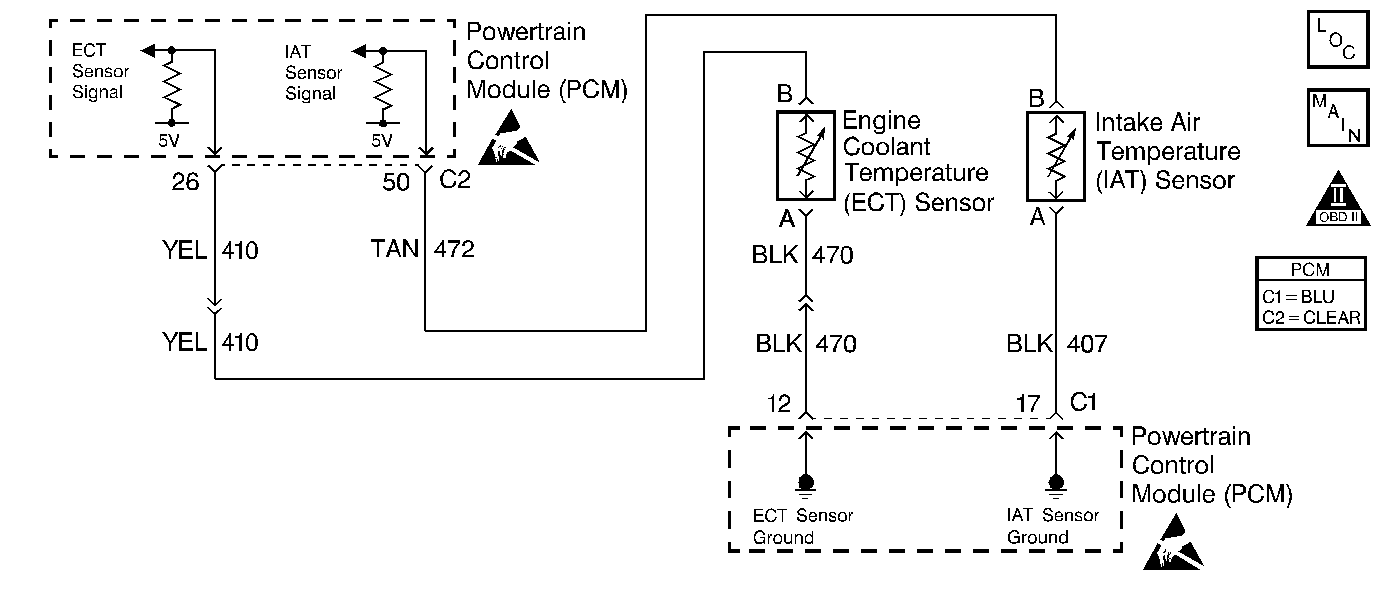
Circuit Description
The engine coolant temperature (ECT) sensor contains a semiconductor--a device that changes resistance based on temperature. The ECT sensor has a signal circuit and a ground circuit. The PCM applies voltage of about 5.0 volts to the sensor on the signal circuit. The powertrain control module (PCM) monitors any voltage changes caused by changes in the resistance of the sensor, and uses this information to determine the engine coolant temperature.
When the engine coolant is cold, the sensor resistance is high, and the PCM signal voltage is only pulled down a slightly through the sensor to ground. The PCM, therefore, senses a high signal voltage or a low coolant temperature. When the engine coolant is warm, the sensor resistance is low, and the signal voltage is pulled down a greater amount. This causes the PCM to sense a low signal voltage or a high temperature.
Conditions for Running the DTC
Engine has been running for longer than 15 seconds.
Conditions for Setting the DTC
The ECT sensor intermittently indicates a coolant temperature greater than 134°C (274°F).
Action Taken When the DTC Sets
| • | The powertrain control module (PCM) stores the DTC information into memory when the diagnostic runs and fails. |
| • | The malfunction indicator lamp (MIL) will not illuminate. |
| • | The PCM records the operating conditions at the time the diagnostic fails. The PCM stores this information in the Failure Records. |
Conditions for Clearing the MIL/DTC
| • | A History DTC will clear after forty consecutive warm-up cycles, if no failures are reported by this or any other non-emission related diagnostic. |
| • | A last test failed (Current DTC) will clear when the diagnostic runs and does not fail. |
| • | Use a scan tool in order to clear the MIL/DTC. |
| • | Interrupting the PCM battery voltage may or may not clear DTCs. This practice is not recommended. Refer to Powertrain Control Module Description , Clearing Diagnostic Trouble Codes. |
Diagnostic Aids
Notice: Use the connector test adapter kit J 35616-A for any test that
requires probing the following items:
• The PCM harness connectors • The electrical center fuse/relay cavities • The component terminals • The component harness connector
Check for the following conditions:
| • | Poor connection at the PCM. |
| Inspect harness connectors for backed out terminals, improper mating, broken locks, improperly formed or damaged terminals, and poor terminal to wire connection. |
| • | Damaged harness. |
| Inspect the wiring harness for damage. If the harness appears to be OK, observe the ECT display on the scan tool while moving connectors and wiring harnesses related to the ECT sensor. A change in the ECT display will indicate the location of the malfunction. |
| • | Skewed or mis-scaled ECT Sensor. |
| Refer to Temperature vs Resistance . |
Reviewing the Failure Records vehicle mileage since the diagnostic test last failed may help determine how often the condition that caused the DTC to set occurs. This may assist in diagnosing the condition.
If the problem is intermittent, refer to Intermittent Conditions .
Step | Action | Value(s) | Yes | No |
|---|---|---|---|---|
1 | Did you perform the Powertrain On-Board Diagnostic (OBD) System Check? | -- | ||
2 | Select DTC info, Last Tst Fail and note any other DTCs set. Is DTC P0118 also set? | -- | Go to DTC P0118 Engine Coolant Temperature (ECT) Sensor Circuit High Voltage . | |
3 | Is DTC P1106, P1111, and/or P1121 also set? | -- | ||
4 |
Was a problem found and corrected? | -- | ||
5 |
Was a problem found and corrected? | -- | ||
6 |
Was a problem found and corrected? | -- | ||
7 |
Was a problem found and corrected? | -- | ||
8 |
Was a problem found and corrected? | -- | ||
9 |
Was a problem found and corrected? | -- | Refer to Diagnostic Aids. | |
10 |
Does the scan tool indicate that this test ran and passed? | -- | ||
11 | Review Captured Info using the scan tool. Are there any DTCs that have not been diagnosed? | -- | Go to the applicable DTC table
| System OK |
